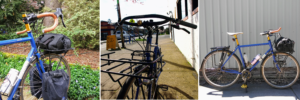
Drop Bars Jones Bars VO Casey’s Bars
What I’ve Learned About Bars:
Bicycle handlebars, like the saddle, can have a major impact on your comfort and enjoyment of the ride. Most casual cyclists never even think about changing the handlebars that came with their bike. But longer and harder rides require that the rider have some options for hand positioning. Riding for an hour or more without being able to move your hands to different positions can lead to stiff and sore muscles. Handlebars that allow you to place your hands in multiple positions can offer relief and keep you on the bike longer. But even casual riders can benefit from more hand placement options or a more comfortable handlebar shape.
I’m a bike mechanic and daily commuter and I usually ride between 5 and 20 miles a day. I think a lot about what handlebars to use and where I’m going to be able to put my hands on them. I went through a journey of trying out a few different types of handlebars to find something that worked well for me and it gave me a lot of insight into what each bar setup does best and worst. I’d love to share this info so others don’t have to do all the re-cabling I did.
Which Bars Are Which?
There are 2 main categories of bicycle handlebars that most daily riders will use: Drop Bars and Flat (or riser) bars. At the end of this post we’ll briefly discuss a few other types of less common handlebar setups that weren’t covered.
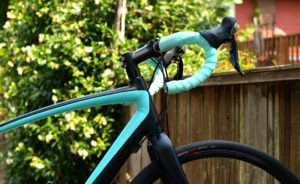
“Drop” bars: The Classic Bicycle Handlebar
Drop bars: These are the 70’s 10-speed Tour De France style racing bars that we all think of on the classic bicycle. These kinds of handlebars give you 3 main hand positions. The “hoods” (hands on brakes/shifters), the “drops” (hands on the bottom portion of the bar to lean forward), and the “tops” (the flat top of the bar closest to the stem, between the brakes/shifters). This versatility is great for racing or long trips as long as your bicycle fits you well. It allows you to move your hands around when they get tired, pull hard on the drops when you want to go fast, and relax on the tops when you want to sit a little more upright. Drop bars are wrapped with “tape” for comfort instead of using “grips” at the end of the bar. A lot of casual riders often find there’s not a comfortable upright hand position with many drop bar bikes and prefer risers or swept back flat bars that bring the hand position closer to the rider.
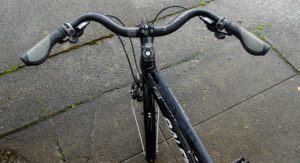
“Flat” Bars or “Risers” can be separate categories but are grouped together for our purposes.
Flat or Riser Bars: These are the simpler style handlebars with grips. They can be flat and straight or they can have some kind of rise, sweep, angle, or curve built in. Often these are separate categories depending on the pursuit. But for most commuters some form of “flat” with some amount of curve and rise (not very flat after all!) is preferred to a more flat mountain bike handlebar. These are often called “touring bars” or “comfort bars” when they offer a lot of rise or bend. For inexperienced cyclists these bars can be much more intuitive than the drop style bars.
Why not drops?
Being born in Portland, OR in 1982 I rode bikes for years before I could ride a bike. I rode in trailers, in child seats and on rigged up seats attached to the top tube holding onto a padded bar that had been welded onto a set of riser handlebars (my dad is an avid cycling enthusiast and welder). Growing up all my handlebars were “risers” or “BMX” bars:
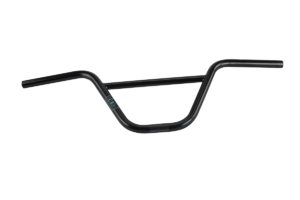
“BMX” bars are “risers” with an additional support bar welded across them.
You almost never see anything else on kids bikes because other bar types are less intuitive and require slightly more skill. Portlands bike culture is commuter-centric so I spent many years thinking of bikes as a utilitarian transportation device. I did little to no customization and gave almost no thought to adjusting the bike to my comfort, something you have to think more about as you age! It wasn’t until I started reading about cycling and looking at pictures of racers and track bikes that I started thinking about using drop bars. At first it was an aesthetic choice, they just looked cooler!
After converting a single speed junker to drop bars I realized that I had been missing out on so many hand positions! I’d go out and ride next to the Columbia river into massive headwinds but it felt amazing because I could get down in the drops, make myself as low and small as possible, cut through the wind and maintain my speed! When I got tired I could still get myself up on the flats in a position akin to having very short flat bars. For most riding I could comfortably rest on the hoods and be upright enough to look around but stretched out enough to put some power into the pedals. I was hooked. I built myself a new fixie with drop bars and brake hoods and rode it everywhere (it was my only bike which was my only transportation besides the bus). I became a faster commuter because it was more fun to go fast with drop bars!
When I moved to Raleigh, NC for 2 years I got a job at a bike shop there. In Raleigh the bike culture is all spandex and racing with very little daily riding or commuting by bike. I did use my bike daily for transportation as I didn’t have a drivers license, but I also did less riding around town and more long distance riding on greenways and quieter, more remote streets. I bought a light road bike and comfy kit and went out on rides where drop bars made it comfortable to keep going fast for an extended period by switching hand positions and getting aero to coast down a long hill.
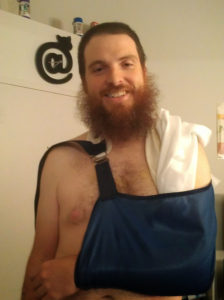
Then I broke my collarbone along with 3 ribs and punctured a lung. All because a car stopped quickly to go into a Wendy’s parking lot. Thanks a lot Dave!
I spent a week in the hospital with a tube in my chest and dreamed about getting back on a bike. It took a little while but when I did start riding again I had trouble using all the same hand positions I’d been used to. It was harder to reach forward as far and for as long as I used to. It took me a while to come to grips with this realization even after fully healed.
I continued to ride with drop bars after I moved back to Portland and started working for Upcycles but I was having back and shoulder pain from reaching forward to the hoods for extended periods.
I tried flared drops that let me get more comfy while holding the drop portion of the bar: the SOMA Gator Bars and the wider (at the hoods) Salsa Cowbell 3 .
They definitely helped but I still couldn’t ride on the drop bars for as long as I could before the accident. I’ve never been a big fan of standard flat handlebars so I tried some risers and swept back “touring bars”. These still only offered ONE hand position so I tried sticking bar ends on various riser and flat bars in different places to create more hand placement options. I created some strange monstrosities that weren’t SUPER comfy but they were a little better leting me know I did still need a lot of places to put my hands.
Between Flats and Risers:
I still wasn’t comfortable so I started looking at more alternatives to drop bars. I’d gotten used to multiple hand positions and I didn’t want to give that up!
I found the Jones H-Bars and the Velo Orange Casey’s Cr*zy Bars
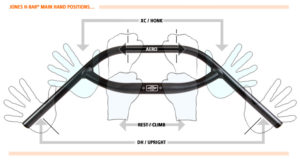
Jones H-Bars
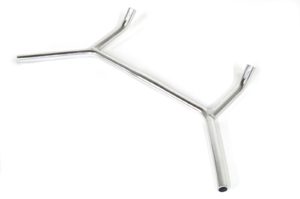
Velo-Orange Casey’s Cr*zy Bars
Both of these handlebar setups as many usable hand positions as drop bars while still maintaining an upright flatbar position. The three main hand positions on these bars are:
- Hands at the end of the bars: Holding the grips at the end of the 45 degree angle swept back portion (default riding position for most bikes). This is the standard comfy riding position that puts me fairly upright. Great for cruising around town leisurely or riding a little faster while still upright enough to keep an eye out for traffic.
- Hands on the bar intersection: This differs between the two because unlike the Velo Oranges the Jones bars have a curve in the tube that the stem clamps onto allowing you to put the shifter and brake lever much farther up the bar. This gives you a VERY long grip to move your hands around. It also places the intersection of the bars, and thus that hand position, further away from you than the Casey’s Bars. Both have their advantages.
- Hands in the forward position: Casey’s bars almost perfectly emulate the forward position of drops (the hoods) when you hold the end of the extensions. This is what I’ve been looking for. The H-Bars don’t offer much of an extension, just a small loop. But that loop gives you some unique hand positions and/or opportunity to attach accessories.
I tried the Jones bars first cause I thought they looked better and less dorky. They were pretty comfortable but I immediately missed having that forward hand position that drop bars offer (the hoods). When I tried to put the pedal to the metal (does that expression work for bikes?) I’d find I couldn’t lean far enough forward to get maximum power to the pedals resulting in me sitting down more, going slower, and crushing it less. Well crushing it is an integral part of my daily commute so I couldn’t have handlebars that slowed me down THAT much! Onto the next ones!
The Velo Orange bars:
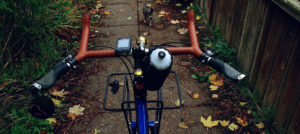
Current Cockpit
I know that these bars aren’t for everyone! But they ended up being the perfect commuting setup for me!
I can mount everything I need and STILL have more places to put my hands than most other bars I’ve seen. That coupled with the forward most hand position that mimics the hoods on drop bars and I’ve found a combination that really ends up being the best of both worlds. I’ve been way more comfortable riding around town. I appreciate switching hand positions regularly even on short rides.
This cockpit setup certainly screams bike dork but hey, we’ve all got to get comfortable with who we are deep down inside! I get a ton of questions from other cyclists which lets me tell people about the MANY handlebar options out there. I find that a lot of people have issues with their current setups but aren’t aware that there are SO MANY options available.
These particular bars may not be your style but there’s bound to be something out there that works really well for you.
What’s your journey?
Sometimes all it takes is some adjustment and tweaking of your current handlebar setup to make you more comfortable. New grips and an angle change can make a big difference. But sometimes the parts that came stock on your bike just aren’t right for you!
At Upcycles we love making your bike better for you. As much as I love my setup I’m sure your handlebar journey won’t take the same route as mine or even have the same concerns. I’ve done the annoying and time consuming part of switching between a bunch of handlebar setups and learning a lot of pros and cons of each and I’d love to pass on those insights to our customers.
Come into Upcycles and let’s discuss what handlebars will work best for you and your riding style.
Even More Options:
These days there are a bunch of other handlebars out there that don’t conform to the flat/drop categorization. They all have pluses and minuses but I didn’t end up using any of them myself so I’ll just include a quick rundown of the three most common:
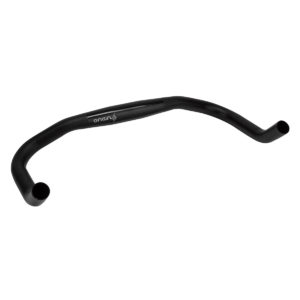
Bullhorn: These give you two of the three hand positions of drop bars, minus the actual drop portion. Usually popular for single speed and fixed gear bikes.
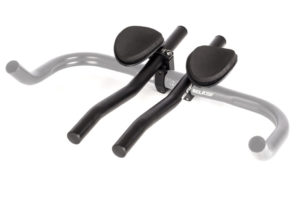
Aero Bars: These are usually attachments that go on top of drop bars or bullhorns made for tucking in, getting aero, and going fast in a straight line. Good for workouts and certain types of races but they make it very hard to steer. Many people think they will be a good comfort option on a commute or around town but I’ve always found they’re too hard to control for city riding and they also tend to get in the way.
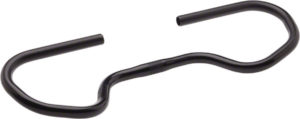
Butterfly Bars: For years before Jones and Velo Orange (and now other companies) started making their variations of multiple hand position bars these were a popular option for touring and they still are! I almost tried out the butterfly bars but I liked the hand placement options on the other bars better.

pastilla cialis
pastilla cialis
Cleocin
Cleocin
long term effects of cialis
long term effects of cialis
i want to buy viagra
i want to buy viagra
viagra for women over the counter
viagra for women over the counter
generic viagra online europe
generic viagra online europe
viagra cream online
viagra cream online
where can i buy female viagra uk
where can i buy female viagra uk
buy viagra australia paypal
buy viagra australia paypal
tadalafil 40 mg with dapoxetine 60 mg
tadalafil 40 mg with dapoxetine 60 mg
discount tadalafil
discount tadalafil
tadalafil canada is it safe
tadalafil canada is it safe
eli lilly cialis coupon
eli lilly cialis coupon
sulfamethoxazole weight loss
sulfamethoxazole weight loss
metronidazole globul
metronidazole globul
gabapentin hoste
gabapentin hoste
valtrex commerce
valtrex commerce
what painkillers can i take with pregabalin
what painkillers can i take with pregabalin
nolvadex equipoise
nolvadex equipoise
prostaglandins lisinopril
prostaglandins lisinopril
metformin datortomografi
metformin datortomografi
lasix fena
lasix fena
side effects of semaglutide shot
side effects of semaglutide shot
semaglutide 20 units
semaglutide 20 units
semaglutide benefits
semaglutide benefits
flagyl användningsområde
flagyl användningsområde
does zoloft make you high
does zoloft make you high
what does cephalexin treat std
what does cephalexin treat std
zosterneuralgie gabapentin
zosterneuralgie gabapentin
escitalopram effects
escitalopram effects
is duloxetine a strong antidepressant?
is duloxetine a strong antidepressant?
generic sildenafil tablets
generic sildenafil tablets
medication keflex
medication keflex
lexapro withdrawl
lexapro withdrawl
how long before fluoxetine works
how long before fluoxetine works
cymbalta info
cymbalta info
cephalexin contraindications
cephalexin contraindications
ciprofloxacin drug interactions
ciprofloxacin drug interactions
bactrim para que es
bactrim para que es
bactrim for uti 3 days
bactrim for uti 3 days
amoxicillin with potassium
amoxicillin with potassium
ddavp indications for use
ddavp indications for use
ezetimibe farmacocinetica
ezetimibe farmacocinetica
what is diclofenac sodium
what is diclofenac sodium
augmentin for cellulitis
augmentin for cellulitis
flomax elderly
flomax elderly
is flexeril an nsaid
is flexeril an nsaid
cozaar manufacturer
cozaar manufacturer
how long does it take depakote to reach therapeutic levels
how long does it take depakote to reach therapeutic levels
unable to climax on effexor female
unable to climax on effexor female
citalopram classification
citalopram classification
diltiazem and alcohol
diltiazem and alcohol
contrave yeast infection
contrave yeast infection
aripiprazole side effects
aripiprazole side effects
how long does aspirin take to work
how long does aspirin take to work
does allopurinol cause weight gain
does allopurinol cause weight gain
amitriptyline para que sirve
amitriptyline para que sirve
bupropion xl 300 mg
bupropion xl 300 mg
ashwagandha cortisol
ashwagandha cortisol
buspar vs xanax
buspar vs xanax
augmentin while pregnant
augmentin while pregnant
side effects of stopping celexa
side effects of stopping celexa
baclofen side effects in adults
baclofen side effects in adults
tramadol and robaxin
tramadol and robaxin
acarbose controindicazioni
acarbose controindicazioni
how much is semaglutide in australia
how much is semaglutide in australia
what are the side effects of protonix
what are the side effects of protonix
remeron off label uses
remeron off label uses
repaglinide 0.5
repaglinide 0.5
actos mecanicos
actos mecanicos
abilify mechanism of action
abilify mechanism of action
alcohol and venlafaxine
alcohol and venlafaxine
stromectol in canada
stromectol in canada
tamsulosin vasodilation
tamsulosin vasodilation
tapering synthroid
tapering synthroid
sitagliptin heart failure trial
sitagliptin heart failure trial
spironolactone potassium
spironolactone potassium
voltaren gel 1% mazatlan mexico
voltaren gel 1% mazatlan mexico
tizanidine hcl 6mg
tizanidine hcl 6mg